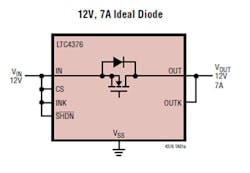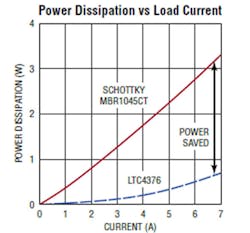Diodes are an essential component in many systems, but using them for reverse-connection protection in automotive and other power applications has one weakness: Their forward voltage drop (which can be as low as 0.3 V for a Schottky device) wastes valuable power while the diode’s self-heating due to resistive loss can significantly limit current-handling and operating range. That’s where a clever analog topology called the “ideal” diode can provide major benefits (obviously, it’s not perfect with 0-Ω on-resistance and thus no voltage drop or dissipation, but it comes surprisingly close).
The just-introduced LTC4376 from Analog Devices is an ideal diode rated at 7 A, targeting nominal 12-V automotive battery protection as well as redundant power supplies, portable battery devices, and computer systems and servers. Although internally far more complex than a diode, it’s externally a simple-to-use, three-terminal device in its basic operating configuration—input, output, and ground (Fig. 1).
1. The LTC4376 7-A ideal diode needs just three connections in its basic operating mode. Remaining package pins support shutdown and other operating modes for additional in-circuit flexibility.
The internal 15-mΩ on-resistance N-channel MOSFET replaces a discrete Schottky diode when used in diode-OR and high-current diode applications, thus reducing power consumption, heat dissipation, and even PC board area. A diode of equivalent current-handling rating would be far larger than its 16-pin 5- × 4-mm DFN package (Fig. 2).
2. As load current increases, the span between the dissipation of this ideal diode and a standard Schottky diode becomes more dramatic and consequential.
In operation, the LTC4376 controls the forward voltage drop across the MOSFET to ensure smooth current delivery without oscillation, even at light loads. If a power source fails or is shorted, a fast turn-off minimizes reverse-current transients. The LTC4376 also easily ORs power sources to increase total system reliability.
Operating current is just 150 μA, and a shutdown pin allows users to invoke a corresponding mode that reduces the quiescent current to 9 μA. The pin can also control the forward current path when an external MOSFET is used in series with the internal MOSFET in a back-to-back configuration.
Operating voltage range is 4 to 40 V with reverse-input protection to –40 V. In addition to the many tables and graphs showing performance under various conditions, the datasheet provides examples of how this ideal diode can be used in a basic circuit, as well as with added features such as undervoltage lockout (UVLO). Versions of the LTC4376 are available for 0 to +70°C, −40 to +85°C, and −40 to +125°C operation; the DC2705A evaluation board is also available. Pricing (1000-piece lots) begins at $2.55.
About the Author

Bill Schweber
Contributing Editor
Bill Schweber is an electronics engineer who has written three textbooks on electronic communications systems, as well as hundreds of technical articles, opinion columns, and product features. In past roles, he worked as a technical website manager for multiple topic-specific sites for EE Times, as well as both the Executive Editor and Analog Editor at EDN.
At Analog Devices Inc., Bill was in marketing communications (public relations). As a result, he has been on both sides of the technical PR function, presenting company products, stories, and messages to the media and also as the recipient of these.
Prior to the MarCom role at Analog, Bill was associate editor of their respected technical journal and worked in their product marketing and applications engineering groups. Before those roles, he was at Instron Corp., doing hands-on analog- and power-circuit design and systems integration for materials-testing machine controls.
Bill has an MSEE (Univ. of Mass) and BSEE (Columbia Univ.), is a Registered Professional Engineer, and holds an Advanced Class amateur radio license. He has also planned, written, and presented online courses on a variety of engineering topics, including MOSFET basics, ADC selection, and driving LEDs.



